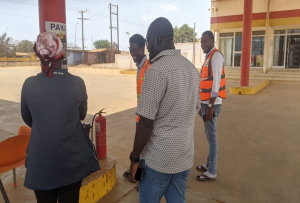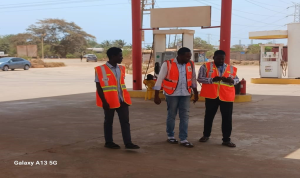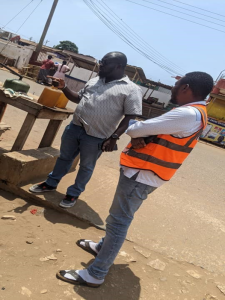The first quarter of the year is characteristically marked by an increased occurrence of fire disasters due to the prevailing dry season. Recognizing this seasonal trend, the Kpone Municipal NADMO implemented a series of proactive interventions focused on fire prevention, public education, and disaster preparedness.
Critical engagements were held with key stakeholders including fuel station operators, informal fuel vendors, and shop owners, a group of motor riders, gas stations, Precious International School, Saint Lawson Memorial School and some residence across the municipality to educate them on the prevention of fire outbreak in the community. These engagements focused on fire safety protocols, emergency preparedness, and regulatory compliance. Additionally, preliminary inspections of major drainage systems were conducted to assess their readiness ahead of the impending rainy season.
These efforts aimed to prevent and mitigate perennial fire outbreaks, reduce emergency response time, and enhance the resilience of the Municipality against both fire and flood related hazards. The objective of the pre-flood assessment exercise is also to identify potential flood risks and provide recommendations to mitigate damage of life, poverty and infrastructure.
ACTIVITIES
As part of the council’s proactive risk reduction strategy, the NADMO team undertook public education and inspection exercises across the Kpone Municipality. The activities targeted fuel filling stations, lorry stations, shops and stores, kiosks, schools and informal fuel vendors (e.g. Table top)
The following key activities were carried out:
- EDUCATION ON THE COMMON CAUSES OF FIRE OUTBREAKS DURING THE DRY SEASON.
- On-site inspection of fire extinguishers to check for expiry and functionality.
- Assessment of staff knowledge and competency in using fire extinguishers.
- Guidance on the development of emergency response plans for businesses and institutions.
- Encouragement of immediate renewal or procurement of fire extinguishers for premises that were without them or had expired ones.
- Engagement with Informal Fuel Vendors
- A significant portion of fire risks in the area stems from the unauthorized sale of fuel in kiosks and on tabletops. Although such practices are not sanctioned, the NADMO Desk adopted a pragmatic approach by engaging these vendors to:
- Acknowledge the hazards posed by their operations.
- Encourage the implementation of basic fire safety measures.
- Promote the acquisition and correct use of fire extinguishers.
- Recommend the formulation of simple emergency response plans.
- This engagement sought to reduce fire outbreaks by instilling safety consciousness, even in unregulated environments.
- ENGAGEMENT WITH INFORMAL FUEL VENDORS.
A significant portion of fire risks in the area stems from the unauthorized sale of fuel in kiosks and on tabletops. Although such practices are not sanctioned, the NADMO Desk adopted a pragmatic approach by engaging these vendors to:
- Acknowledge the hazards posed by their operations.
- Encourage the implementation of basic fire safety measures.
- Promote the acquisition and correct use of fire extinguishers.
- Recommend the formulation of simple
This engagement sought to reduce fire outbreaks by instilling safety consciousness, even in unregulated environment.
- DRAINAGE INSPECTION AND FLOOD PREPAREDNESS
In anticipation of the rainy season, NADMO conducted inspections of key drainage systems to assess their current condition and identify areas requiring immediate intervention. Key findings include: Several storms drain across the municipality were found to be heavily silted and choked with waste, impeding free water flow.
- Specific attention was drawn to the main drainage channel at Drokor Bridge, which connects to the Kpone community. This drain is significantly silted and requires urgent desilting before the onset of heavy rains.
During community engagements, residents, shop owners, and local businesses situated along drainage lines were sensitized and encouraged to collaborate and organize clean-up exercises in their areas.
ACHIEVEMENTS
- Over twenty-five (25) fuel stations, shops, and kiosks were engaged and inspected for fire safety compliance.
- Multiple informal fuel vendors were sensitized on the risks associated with their operations and were encouraged to adopt safety practices.
- Several expired or missing fire extinguishers were identified, with vendors advised on immediate renewal or acquisition.
- Emergency preparedness awareness was improved through capacity-building engagements.
- Critical drainage systems were identified and documented for desilting in preparation for the rainy season.
CHALLENGES
- We also observed inadequate drainage systems, clogged storm drains and poor waste management practices.
- Most areas were identified with soil erosion, landslides and unstable slopes.
- Most areas still experience temporal flood situations. There were few fish floods, very muddy compounds, paths and roads.
- Lack of funds /means of transportation to the field for educational and assessments.
- Lack of cooperation from victims due to slow response of relief items during reassessments.
- Lack of logistics.
- Encroachment on water ways and identified some buildings on water ways.
- Souvenirs like brochures and fliers to make our education ways for the people to understand.
RECOMMENDATIONS
- Means of transportation; the Assembly should provide means of transportation (motor/vehicle) to aid effective work delivery since some parts of the zones are very far and we find it difficult reaching out for some activities.
- If possible, field trip allowance should be given to staffs as motivation.
- Unauthorized structures should be removed. We recommend that structures located on water ways should be removed to make way for the running rain water to make freely.
- Desilting of gutters. We recommend the regular desilting of the drains in the various communities.
- Enforce regular fire safety audits in all commercial spaces, especially those dealing with flammable substances.
- Establish fire drills and simulation exercises for high-risk institutions and community groups.
- Engage Environmental Health and Works Departments to coordinate desilting and waste management in and around drains.
- Prioritize the desilting of the Drokor Bridge drainage channel to prevent flooding during the next quarter.
- Create local emergency task forces to enhance rapid response capacity within the flood prone communities.
- Introduce formal training for informal vendors on safe handling and storage of flammable products.
CONCLUSION
The first quarter’s activities have yielded significant strides in public safety awareness, fire prevention, and early flood preparedness. While challenges remain, particularly among unregulated fuel vendors and inadequate drainage maintenance, the proactive engagements and inspections have laid a solid foundation for improved disaster risk reduction and community resilience.
REPORT IN PICTURES



